Investors balked at the U.S. Treasury's auction of 30-year bonds as Federal Reserve Chairman Jerome Powell cited low inflation as grounds for a potential interest-rate reduction that's widely expected at the end of this month.
Bidders at the Thursday sale drove the yield on the re-opened bond line, which was first auctioned in May, to 2.64 percent. That was almost three basis points above the prevailing market level at the bidding deadline, and compared with 2.607 percent at last month's sale. The dropoff in demand—which was also reflected in a weaker-than-average bid-to-cover ratio—showed investors pushing back on the rallies that took the 30-year yield to a multiyear low of around 2.45 percent earlier this month.
Yields on 30-year debt climbed as much as 8 basis points on the day to 2.66 percent, extending the selloff in longer-end Treasuries that followed the release of stronger-than-expected consumer price inflation data earlier in the U.S. morning. The 30-year yield was more than 10 basis points below current levels just before Federal Reserve Chairman Powell's dovish testimony Wednesday.

“The curve should be a lot steeper,” said Glen Capelo, a trader with Academy Securities. “This is the first time in my lifetime the Fed is actually trying to create inflation,” he said by email after the auction.
Take-up at Thursday's auction was particularly poor among indirect bidders, a class of investors that includes pensions and mutual funds. Their share of 50 percent was the lowest since February 2015, and well below the 60.8 percent they took at the prior auction in May.
— With assistance from Elizabeth Stanton.
© Touchpoint Markets, All Rights Reserved. Request academic re-use from www.copyright.com. All other uses, submit a request to [email protected]. For more inforrmation visit Asset & Logo Licensing.



